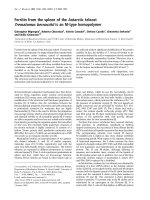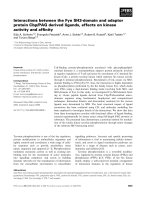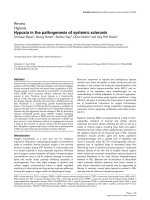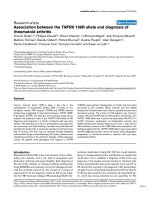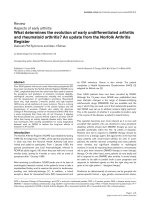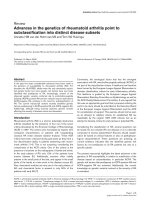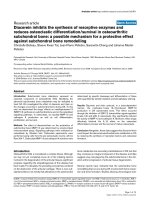Báo cáo y học: "Bench-to-bedside review: The MET syndrome – the challenges of researching and adopting medical emergency teams"
Bạn đang xem bản rút gọn của tài liệu. Xem và tải ngay bản đầy đủ của tài liệu tại đây (224.12 KB, 6 trang )
Page 1 of 6
(page number not for citation purposes)
Available online />Abstract
Studies of hospital performance highlight the problem of ‘failure to
rescue’ in acutely ill patients. This is a deficiency strongly
associated with serious adverse events, cardiac arrest, or death.
Rapid response systems (RRSs) and their efferent arm, the
medical emergency team (MET), provide early specialist critical
care to patients affected by the ‘MET syndrome’: unequivocal
physiological instability or significant hospital staff concern for
patients in a non-critical care environment. This intervention aims to
prevent serious adverse events, cardiac arrests, and unexpected
deaths. Though clinically logical and relatively simple, its adoption
poses major challenges. Furthermore, research about the effective-
ness of RRS is difficult to conduct. Sceptics argue that inadequate
evidence exists to support its widespread application. Indeed,
supportive evidence is based on before-and-after studies, obser-
vational investigations, and inductive reasoning. However, imple-
menting a complex intervention like RRS poses enormous logistic,
political, cultural, and financial challenges. In addition, double-
blinded randomised controlled trials of RRS are simply not
possible. Instead, as in the case of cardiac arrest and trauma
teams, change in practice may be slow and progressive, even in
the absence of level I evidence. It appears likely that the
accumulation of evidence from different settings and situations,
though methodologically imperfect, will increase the rationale and
logic of RRS. A conclusive randomised controlled trial is unlikely to
occur.
All truth passes through three stages.
First, it is ridiculed.
Second, it is violently opposed.
Third, it is accepted as being self-evident.
Arthur Schopenhauer (1788-1860), German philosopher
Introduction
Hospitals now treat increasingly complex patients. Despite
the growth of technology and the development of new
medications, 10% to 20% of hospitalised patients develop
adverse events, with an overall hospital mortality of 5% to 8%
[1-3]. Importantly, an estimated 37% of these events may be
preventable [3]. Multiple studies from Europe, the US, and
Australia have also confirmed deficiencies in the way
hospitals and ‘traditional’ models of care respond to acute
illness in the wards [4-7]. One deficiency of the hospital
system’s approach to acute illness is the problem of ‘failure to
rescue’ [8]: failure to deliver rapid and competent care to an
acutely ill ward patient. Traditionally, hospitals have left such
rapid responses to either the parent unit or cardiac arrest
teams. Unfortunately, the parent unit doctors are often unable
to attend the patient rapidly or are not specifically or sufficiently
trained in acute resuscitation [4-7]. Although cardiac arrest
teams have been around for decades, they often arrive at the
end of the disease cascade, are unsuccessful in greater than
85% of patients, and patients so treated may survive the arrest
but carry a high risk of hypoxic brain injury [9-11]. These
observations suggest that earlier recognition of disease
progression provides the opportunity to avert major adverse
events in many cases. In others, it provides the opportunity to
put in place a terminal care plan that prevents unnecessary
interventions and an undignified death.
Early recognition of an ‘at-risk’ situation is important in
ensuring patient safety. Physiological warning signs (instability)
of impending cardiac arrest have been repeatedly demon-
strated to be common [6,8-10] and to precede such events
by several hours, with 60% to 84% of cardiopulmonary arrest
patients showing physiological instability within 6 to 8 hours
of the event [12,13]. However, in traditional systems, the
hospital’s response is often late and inadequate [12-24]. The
outcome of this approach has not improved in 50 years. Clear
evidence of inadequate ward care was provided by a study
from the UK [6] which found that, prior to intensive care unit
(ICU) admission, suboptimal management of oxygen therapy,
Review
Bench-to-bedside review: The MET syndrome – the challenges of
researching and adopting medical emergency teams
Augustine Tee, Paolo Calzavacca, Elisa Licari, Donna Goldsmith and Rinaldo Bellomo
Department of Intensive Care and Department of Surgery (Melbourne University), Austin Hospital, Studley Road, Heidelberg, Melbourne, Victoria 3084,
Australia
Corresponding author: Rinaldo Bellomo,
Published: 23 January 2008 Critical Care 2008, 12:205 (doi:10.1186/cc6199)
This article is online at />© 2008 BioMed Central Ltd
ICU = intensive care unit; MERIT = Medical Emergency Response Improvement Team; MET = medical emergency team; RRS = rapid response
system.
Page 2 of 6
(page number not for citation purposes)
Critical Care Vol 12 No 1 Tee et al.
airway, breathing, circulation, and monitoring occurred in over
half of patients. These errors were essentially due to the
failure to apply or appreciate the need for basic resuscitation
measures. Major causes of suboptimal care included failure
of organisation, failure to appreciate clinical urgency, and
failure to seek advice [6]. In summary, there is much evidence
that ‘failure to rescue’ is common in patients at risk for major
adverse events. There is also evidence that failure to
appreciate the clinical urgency of situations is common, that
the knowledge and skills to deal with such situations are
limited among ward doctors and nurses, and that, in most
patients, there are warning signs for a long enough period to
allow appropriate action to be taken.
Critical care for the critically ill anywhere in
the hospital
The concept of rapid and early rescue is well established in
various fields of medicine, especially in trauma, cardiology, and,
more recently, severe sepsis and septic shock [25-27]. It would
make sense to apply these concepts to critical illness in general,
wherever it may occur in the wards, and to use an RRS to
deliver early intervention by specifically trained teams. In this
regard, it is important to realise that, in most hospitals, the
expertise exists to rapidly deliver the skills and knowledge to the
bedside when necessary to deal with critical illness. Critical care
physicians and critical care nurses can theoretically deliver such
expertise anywhere in the hospital within minutes.
The field of critical care medicine has made considerable
progress in improving outcomes of critically ill patients. Given
that most acute illness develops through stages of deteriora-
tion, the logical step surely would be to bring intensive care
equipment and expertise to any acutely ill patient, irrespective
of location within the hospital, in what has been described as
creating a ‘critical care system without walls’ [28]. The
medical emergency team (MET) brings this expertise to the
patient in a timely manner and supplies the ‘efferent arm’ of
this process of identification of at-risk patients and rapid
delivery of appropriate care, designated recently as the rapid
response system (RRS) [29].
Because the care of critically ill patients is their core specialty
competency, intensive care doctors and nurses are ideally
placed to provide immediate care to patients who are
critically ill: they are acute illness specialists. The value of
specialists in expert management of specific disease
conditions is widely accepted. Specialists are so named
because they are trained with particular skills and in-depth
knowledge. It would seem illogical for inadequately trained
doctors to treat acutely ill patients instead of critical care
physicians and nurses being responsible for their
management [30].
Common sense or science
The concepts presented above seem, at face value, to simply
represent common sense. However, in an era of ‘evidence-
based medicine’, the efficacy of the MET and utility of the
RRS have been criticised for lacking sufficient high-quality
evidence in the form of randomised controlled trials. Meta-
analytical techniques have been used to demonstrate the
weakness of such evidence [31,32]. For example, in a recent
meta-analysis by Winters and colleagues [32], although the
respective relative risks (95% confidence intervals) for
hospital mortality and cardiac arrest were 0.76 (0.39 to 1.48)
and 0.94 (0.79 to 1.13) (suggesting a benefit), the authors
concluded that the heterogeneity of the studies and wide
confidence interval suggest that adopting RRS as a standard
of care is premature and possibly wrong.
In our opinion, however, there are unique issues surrounding
RRS which need to be taken into account when interpreting
the available evidence. First, these systems are not simple
tablets whose efficacy or effectiveness can be tested in
double-blind randomised controlled trials [33]. Second, these
systems are complex human activities. They require consider-
ation of several important anthropological, organisational,
political, logistic, and administrative aspects [29]. These
aspects profoundly affect the implementation, performance,
and efficacy of such systems. Third, acceptance of the
cultural changes associated with the introduction of RRS
requires time, making early assessment of such systems
flawed and non-representative of their later performance
[29,34]. Accordingly, the challenges surrounding the imple-
mentation of such systems require detailed discussion.
The challenges of implementing rapid
response systems
Even when the concept of RRS is believed to be advan-
tageous, the actual implementation entails overcoming a
myriad of barriers: political, financial, educational, cultural,
logistic, anthropological, and emotional (Table 1). Some of
these challenges are particularly important to consider.
Rapid response system breaks with ‘tradition’
The culture of ward doctors managing acutely unwell patients
is changed by the introduction of RRS. We have seen this at
our institution, where ICU doctors and nurses are no longer
viewed as experts confined to the ‘ivory tower’ of the ICU but
are now constantly assessing and helping to treat ‘at-risk’
patients in general wards [35]. This paradigm shift in our
hospital culture and medical practice has changed how the
roles of ICU and hospital doctors and nursing staff are being
viewed. Nevertheless, allegiance to the traditional approach
of initially calling the parent medical unit doctors when there
are objective early signs of clinical deterioration is difficult to
eradicate: 72% of nurses surveyed continue to choose to call
the parent unit first, despite several years of RRS operation
[36]. It is an extraordinary challenge to change ‘culture’.
Rapid response systems challenge medical ‘power’
The MET patient is created by the environment and the
disease and not by the disease per se. This implies a
Page 3 of 6
(page number not for citation purposes)
mismatch between resources and needs as a component of
the syndrome. The arrival of the MET brings a critical care
environment to the bedside. In a sense, when an MET syn-
drome develops, it could be argued that both the hospital and
the patient are ‘sick’ [37]. Occasionally, errors that underlie
the development of the MET syndrome naturally surface
during an MET review [38]. This often causes parent medical
unit doctors and ward nurses to worry about criticism. It is
important to emphasise that the MET service is ‘hospital
policy’ and that no hospital staff should be reprimanded for
calling the MET. Similarly, it is vital to reiterate that the MET
intervention does not represent an attempt by the ICU staff to
take over patient management [35]. Despite these assur-
ances, many doctors remain uncomfortable over the
perceived loss of control and the fact that nurses can activate
the MET without requiring permission from them. Ignoring
these problems and not seeking to reassure medical staff is
likely to increase the chance of failure of an RRS.
Rapid response systems give ward nurses more power
As nurses are in direct patient contact most of the time, they
also need and call an MET most. Surveys have shown that a
majority of nurses welcome the availability of an MET service,
with 84% feeling that it improves their work environment and
65% considering it a factor when seeking a new job in an
institution [39,40]. The MET enables the nurse to exercise
independent judgement and to call for immediate assistance
should the patient fulfill a predetermined set of clinical
criteria. He or she can bypass the delay often apparent with
calling for help through a hierarchy of medical and nursing
staff. This is seen even in experienced nurses, who in an
Australian survey were found to be more likely to activate an
MET [40]. Nurses are the most powerful and numerous allies
of RRS.
Staff may be ashamed to call a medical emergency team
The issue of professional pride or fear of blame has to be
overcome. Activation of an MET does not imply that ward
personnel are incapable or unwilling to manage the patient
themselves. This aspect must be emphasised in educational
and preparation sessions. Hospital administration supporting
the MET system needs to engage all staff in a re-orientation
from individual to system thinking [41]. Policies should be
widely available and regularly reinforced and communicated
by senior hospital staff. As data collection and audits are part
of the feedback arm of the MET [29], positive action should
be taken to encourage favourable staff behaviour.
Ward monitoring needs constant improvement
Several studies have shown a circadian pattern of activation of
MET [42-44]. This peculiar variation is most likely explained by
the interaction between ward staff caring for the patient and
the monitoring tools used. Such variation is absent in the ICU,
where more extensive monitoring and a higher nurse/patient
ratio are standard [43]. Recordings of early signs of critical
conditions were 7.7 times more frequent than late signs, with
nurses accounting for 86.1% of these [45]. Interestingly, in
that study, 17.8% of all recordings of early signs and 9% of
late signs were judged by nurses to be ‘usual for the patient’.
These commonly included mild hypoxaemia, hypercarbia, and
hypotension. As the MET call criteria depend heavily on
physiological alteration of signs, poor monitoring equipment,
methods, and recognition by staff may be a major stumbling
block in improving outcomes and RRS performance. Regular
staff educational programs and audits of technology and
processes of care are necessary to minimise these problems.
Major delays in calling a medical emergency team
Despite positive attitudes toward the MET system, nurses
may not always follow the predetermined MET activation
criteria or may fail to recognise when assistance is required.
Daffurn and coworkers [46] showed, in a study conducted
2 years after implementation of an MET system, that nurses
variably correctly identified scenarios warranting an MET call
in 17% to 73% cases. Hypotension did not appear to alert
nurses to summon assistance, and some nurses would still
call a resident rather than the MET in the presence of severe
deterioration and patient distress. Unpublished data from our
experience confirm that delays in calling an MET are
associated with increased in-hospital mortality (Figure 1) and
that even a minor delay has a substantial effect on outcome.
These observations highlight another challenge in the
adoption and research of such systems. If deficient MET
systems are tested, they may fail to show a clinical benefit.
No matter how good the system is, major methodological
challenges need to be overcome to evaluate such systems in
a rigorous and clinically relevant way.
Evaluating the medical emergency team system
Medical technologies and drugs are assessed using
methodology favouring the statistical power of large numbers
Available online />Table 1
Implementation difficulties with the rapid response system
Difficulties of implementing the rapid response system
Breaks from traditional hierarchy of medical consults
Challenges medical ‘power’
Gives ward nurses more independent authority
Perceived shame in calling the MET
Inefficient ward monitoring of physiological signs
Delay in activating the MET
Non-clinical challenges
logistics
financial
educational
cultural
emotional
anthropological
political
MET, medical emergency team.
and certain study designs. This approach dismisses real-life
relevance, Bayesian logic, and common sense as too biased
and methodologically flawed. Though scientifically valid, this
approach fails to achieve a balance between rigour and real-
life evidence in assessing process improvement [33]. The
effectiveness of the MET is related to a systematic change in
the way hospitals deliver care. An alternative, ‘pragmatic
science’ approach by Berwick [47] promotes tracking effects
over time, integrating detailed process knowledge into the
work of interpretation, using small samples and short experi-
mental cycles of change, and using multifactorial designs in
evaluating system change. According to this paradigm,
common sense practices like bringing critical care expertise
to acutely ill ward patients might not require randomised
controlled trials and other evidence-based methodology
before incorporation into practice. We note that no
randomised multicentre double-blind controlled trials exist to
test the effectiveness of hand-washing by doctors and
nurses.
Even if one intended to conduct a randomised controlled trial
of METs within an institution, this would be made nearly
impossible by the Hawthorne effect [48]. This effect would
artificially lead to an improvement in the care of control
patients, with doctors and nurses imitating the intervention
being studied. It is also unethical to randomly assign acutely
ill patients, as it would deny potentially life-saving
interventions to those randomly assigned to ‘placebo’.
Adequately matched case-control studies, though not
considered sufficiently rigorous, may avoid some of the short-
comings [49]. As a consequence, only hospitals can become
the unit of randomisation (cluster randomisation) [50]. In the
largest cluster randomised study of METs [51], the Medical
Emergency Response Improvement Team (MERIT) study,
investigators randomly assigned participating hospitals to
standard care or the introduction of an MET. The result was
an increased overall MET calling rate in MET hospitals but no
substantial effect on cardiac arrest, unplanned ICU admis-
sions, or unexpected death. However, that study had major
shortcomings from severe lack of statistical power due to the
large variance in outcome incidence and wide standard
deviation and the lower-than-expected incidence of the
outcome measures under investigation. Given the incidence
and variance of such outcomes, more than 100 hospitals
would have been needed to show a 30% difference in the
composite outcome, whereas only 23 hospitals were actually
recruited. Inadequate and non-uniform implementation of the
MET was also an issue in MERIT as there was a lack of a
continued educational process throughout the study period.
Furthermore, the call rate in MERIT was much lower (<20%)
than that seen in hospitals implementing successful MET
programs. This is not surprising as the evaluation time was
only 6 months. Typically, such systems require more than a
year or two to mature.
Before-and-after studies
The current literature on MET shows many examples of
before-and-after studies dealing with single-centre data
[52-56]. Inherent within this type of evidence is the lack of
rigour and generalisability. Furthermore, the magnitude of the
effect of the MET may be influenced by institution-specific
administrative features and policies. Buist and coworkers
[52] showed a 50% reduction in the incidence of cardiac
arrests, whereas a study by DeVita and colleagues [54]
reported a 17% decrease. Data from our institution [53]
revealed a 65% relative risk reduction in a 4-month compari-
son study in surgical patients. Of note, almost all studies
point to an effect of the MET in reducing cardiac arrests. The
type of patients evaluated does appear to differ in outcomes,
with surgical postoperative cases benefiting the most in
terms of mortality reduction [55,56]. Despite methodological
shortcomings, the MET has proliferated in hospitals, although
controversy continues over whether it should be a standard of
care (Table 2). Even if one believed in the concept of MET,
adopting the MET poses major political and logistic
challenges. One has to convince colleagues, educate nurses
and doctors, maintain awareness, and ensure collegiality and
performance [34,57-59]. Time is needed for the MET
concept to ‘bed in’ [58] in order to reap its benefits in a
substantial manner. Repeated education and periodic
assessment of site-specific obstacles to utilisation of MET
should be addressed [59]. If education and staff awareness
can be maintained after the initial introduction, the MET
system continues to increase in efficacy. Short-term studies
may therefore underestimate its impact [34]. RRSs with their
MET components are not easy, nor are they simple. Yet, they
are worth the effort.
Critical Care Vol 12 No 1 Tee et al.
Page 4 of 6
(page number not for citation purposes)
Figure 1
The effect of delay in medical emergency team (MET) calls on mortality
in two cohorts of patients at the start of an MET program and 5 years
later. *p <0.001; **p <0.004.
Gaps and knowledge and future research
Our understanding of the issues that surround RRSs is very
limited. Only a few studies have been conducted in even
fewer centres. The gaps in our knowledge define the future
research agenda. We know little about the epidemiology of
abnormal vital signs in hospital patients and the outcome of
patients who experience them. We know little about the
specificity and sensitivity of specific vital sign abnormalities
and/or of clusters of such signs. We do not know whether
improved monitoring technology with increased automation of
vital sign recording and with advisory response systems can
decrease adverse events or improve team activation. We do
not know about the anthropology and psychology of how
nurses and doctors currently respond to changes in patient
status and why they do or do not activate RRSs. We do not
know what teams do at the bedside which is useful and what
they do at the bedside which is not useful. We have very little
information on how such teams affect the issuing of not-for-
resuscitation orders in ward patients who are acutely ill. We
have limited knowledge of how such systems might affect
surgical patients differently from medical patients and how
activation may occur differently in different specialty areas. In
short, the gaps in our knowledge are wide and the research
agenda equally big. Yet the process has just begun and there
is growing momentum in terms of clinical application and
investigation. It is likely that, once critical care physicians
realise this is a new frontier for the specialty, we will be able
to start filling these gaps step by step.
Conclusion
Translating common sense into evidence for a complex
intervention like MET poses enormous challenges, and only
progressive accumulation of evidence from different settings
and situations will ultimately sway physician behaviour. A
conclusive randomised controlled trial is unlikely to occur.
Medical leadership needs to acknowledge the fact that
acutely ill patients in the wards should be identified rapidly
and that critical care expertise, resources, and personnel
should be delivered to the bedside of the critically ill wherever
they are. In the words of the slogan of the American Society
of Critical Care Medicine, we need to deliver the ‘right care,
right now’. Hospital wards should be no exception.
Competing interests
The authors declare that they have no competing interests.
References
1. Brennan TA, Leape LL, Laird NM, Hebert L, Localio AR, Lawthers
AG, Newhouse JP, Weiler PC, Hiatt HH: Incidence of adverse
events and negligence in hospitalised patients: results of the
Harvard Medical Practice Study I. N Engl J Med 1991, 324:
370-376.
2. Leape LL, Brennan TA, Laird N, Lawthers AG, Localio AR, Barnes
BA, Hebert L, Newhouse JP, Weiler PC, Hiatt H: The nature of
adverse events in hospitalized patients: results of the Harvard
Medical Practice Study II. N Engl J Med 1991, 324:377-384.
3. Baker GR, Norton PG, Flintoft V, Blais R, Brown A, Cox J, Etchells
E, Ghali WA, Hébert P, Majumdar SR, et al.: The Canadian
Adverse Events Study: the incidence of adverse events among
hospital patients in Canada. CMAJ 2004, 170:1678-1686.
4. McGlynn EA, Asch SM, Adams J, Keesey J, Hicks J, DeCristofaro
A, Kerr EA: The quality of health care delivery to adults in the
United States. N Engl J Med 2003, 348:2635-2645.
5. Wilson RM, Runciman WB, Gibberd RW, Harrison BT, Newby L,
Hamilton JD: The quality in Australian health care study. Med J
Aust 1995, 163:458-471.
6. McQuillan P, Pilkington S, Allan A, Taylor B, Short A, Morgan G,
Nielsen M, Barrett D, Smith G: Confidential inquiry into quality
of care before admission to intensive care. BMJ 1998, 316:
1853-1858.
7. Hershey CO, Fisher L: Why outcome of cardiopulmonary
resuscitation in general wards is poor. Lancet 1982, 1:31-34.
8. Emergency Care Research Institute (ECRI): Rapid response
teams improve quality/safety. The Risk Management Reporter
2006, 25:1-9.
9. Dumot JA, Burval DJ, Sprung J, Waters JH, Mraovic B, Karafa MT,
Mascha EJ, Bourke DL: Outcome of adult cardiopulmonary
resuscitations at a tertiary referral center including results of
‘limited’ resuscitations. Arch Intern Med 2001, 161:1751-1758.
10. Sandroni C, Nolan J, Cavallaro F, Antonelli M: In-hospital cardiac
arrest: incidence, prognosis and possible measures to
improve survival. Intensive Care Med 2007, 33:237-245.
11. Paniagua D, Lopez-Jimenez F, Londoño JC, Mangione CM, Fleis-
chmann K, Lamas GA: Outcome and cost-effectiveness of car-
diopulmonary resuscitation after in-hospital cardiac arrest in
octogenarians. Cardiology 2002, 97:6-11.
12. Schein RM, Hazday N, Pena M, Ruben BH, Sprung CL: Clinical
antecedents to in-hospital cardiopulmonary arrest. Chest
1990, 98:1388-1392.
13. Kause J, Smith G, Prytherch D, Parr M, Flabouris A, Hillman K:
Australian and New Zealand Intensive Care Society Clinical
Trials Group. A comparison of antecedents to cardiac arrests,
deaths and emergency intensive care admissions in Australia
and New Zealand, and the United Kingdom—The ACADEMIA
study. Resuscitation 2004, 62:275-282.
14. Buist MD, Jarmolowski E, Burton PR, Bernard SA, Waxman BP,
Anderson J: Recognising clinical instability in hospital patients
before cardiac arrest or unplanned admission to intensive care. A
pilot study in a tertiary-care hospital. Med J Aust 1999, 171:22-25.
Available online />Page 5 of 6
(page number not for citation purposes)
Table 2
Research difficulties with the rapid response system
Difficulties with researching the rapid response system
Dismisses real-life relevance and common sense
Dependence of randomised trial methodology on numerical
strength, which requires patient randomisation
Hawthorne effect improves outcomes in control patients
Unethical to randomly assign patients to ‘placebo’
Cluster randomisation of hospitals requires large numbers of
centres
Before-and-after studies lack rigour and generalisability
This article is part of a review series on
Translational research
,
edited by
John Kellum
.
Other articles in the series can be found online at
/>theme-series.asp?series=
CC_Trans



